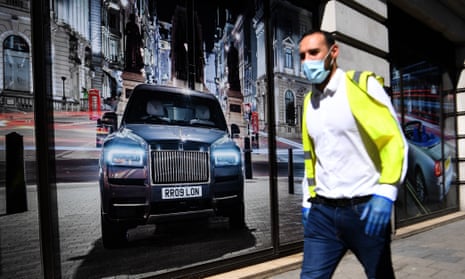Britain’s economy is on course for a slow rebound from the coronavirus outbreak amid mounting business concern over the hit to consumer demand, despite early signs of improvement in May.
After April’s unprecedented economic slump as lockdown measures brought the UK economy to an effective standstill, the latest monthly health check for growth and jobs from IHS Markit and the Chartered Institute of Procurement and Supply (Cips) suggested the economy has recovered slightly this month.
Its flash composite purchasing managers’ index (PMI) – which provides a snapshot of business activity using company surveys – rose to 28.9 this month from a record low of 13.8 in April. However, that is still far below the 50.0 mark that separates economic growth from contraction. The reading was also worse than the lowest point of the 2008 financial crisis.
Q&AWhat is a recession?
Show
One of the two main definitions of recession in the UK is at least two quarters of shrinking gross domestic product (GDP), the broadest measure of economic prosperity. Judged by this yardstick, the UK was last in recession in 2008-09, when there were six consecutive quarters of negative growth.
The economic shock triggered by the coronavirus pandemic caused GDP to fall by 2.2% in the first quarter of 2020 and by 20.4% in the second – the sharpest decline since modern records began in 1955.
Some economists believe this definition of recession is flawed, since an economy would not be in recession if it contracted by 5% in the first quarter, expanded by 0.1% in each of the following two quarters and then contracted again by 5% in the fourth quarter. It would, however, be deemed to be in recession if it grew by 5% in each of the first and fourth quarters but contracted by 0.1% in each of the second and third quarters.
An alternative – and tougher definition – is a full calendar year of negative output. Given the UK economy has grown on average by 2.5% over many decades, it is rare for gross domestic product (GDP) to fall on an annual basis. There have been only five such years since the end of the second world war: 1974, 1975, 1980, 1981 and 1991.
The US has its own method of assessing recession, with the National Bureau of Economic Research's business cycle-dating committee making a judgment.
The NBER defines recession as "a significant decline in economic activity spread across the economy, lasting more than a few months, normally visible in real GDP, real income, employment, industrial production and wholesale-retail sales".
The survey shows Britain remains firmly locked in an unprecedented downturn, with sharply lower levels of activity. Many businesses have remained closed during the Covid-19 outbreak, while others have suffered cancelled customer orders and a general slump in demand.
Separate figures published by the Confederation of British Industry showed that manufacturing output dropped at the fastest rate since comparable records began in 1975 during the three months to May.
According to a survey of 385 manufacturers by the industry lobby group, production plunged in 15 out of 17 sectors. The steepest declines were at car factories and sites producing food, drink and tobacco. Export orders for UK factories collapsed at the fastest rate since 1998.
Sounding the alarm that the pace of recovery would be muted, companies told the survey they expected production to fall at a slightly slower – but still rapid, in historical terms – pace in the next three months.
Anna Leach, deputy chief economist at the CBI, said manufacturers are “bracing for what will be a challenging period”.
She urged the government to show flexibility in the support it was offering so that “the manufacturing sector can exit the lockdown with as little permanent damage possible”.
Chris Williamson, the chief business economist at IHS Markit, said Britain appeared to be reopening more slowly than other countries due to the scale of the public health emergency compared with other nations.
Warning that business confidence was struggling to recover, and with Brexit just around the corner, he said: “The UK looks set to see a frustratingly slow recovery, given the likely slower pace of opening up the economy relative to other countries which have seen fewer Covid-19 cases.
“Virus-related restrictions, widespread job insecurity and weak demand will be exacerbated by growing business uncertainty regarding Brexit.”
The figures come after the chancellor, Rishi Sunak, played down hopes for a rapid economic rebound from the coronavirus crisis. The government had been hoping for a sharp V-shaped recovery from the pandemic, but the chancellor said the “jury is out” on the “degree of long-term scarring” on the UK economy.
IHS Markit forecasts GDP to fall by almost 12% in 2020. “The recovery will be measured in years, not months,” Williamson said.
Figures from the eurozone earlier on Thursday suggested business activity in the single currency bloc was slightly stronger than in Britain. The eurozone composite PMI increased to 30.5 in May from a record low of 13.6 in April.
In a reflection of the gradual lifting of lockdown measures, separate figures from the Office for National Statistics showed 6% of businesses currently open for business had restarted trading in the two weeks to 3 May. Almost four-fifths of firms across the country are still trading, although the vast majority are using emergency state support.
According to the ONS, the sector of the economy that includes hotels, restaurants and takeaways reported the largest percentage of firms restarting trading over the period, followed by construction and manufacturing.
